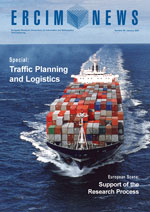by Peter Nijkamp
EuroHORCs (European Heads of Research Councils) is a platform for principals (chairs, presidents, CEOs) of national research organisations and funding bodies to meet to discuss common issues and develop new initiatives. The organisation bears an enormous responsibility to the research landscape in Europe, having a joint annual budget exceeding 20 billion euros - far higher than the EU Framework Programme (FP) budget. Thus, the organisations represented in EuroHORCs are essential players in both national research systems and in the European Research Area (ERA).
While in the past Europe has developed a patchwork of nationally-based research funding systems, it is increasingly recognizing the need to sharpen its focus in R&D, in order to cope with emerging global scientific challenges. Europe cannot afford to lose its research talent in a global science market and must therefore take effective action in order to become a favourite research region for promising talent.
The European Response
There is a clear need for a more coherent and effective joint research policy in Europe. Recent decades have already witnessed a gradual transition towards greater cooperation, mainly in the context of the various FPs. However, a rigorous attempt to achieve coordination between cutting-edge European research programmes has so far been missing, and new initiatives are necessary. The linking and integration of national research programmes funded by the EU and by national funds is a potentially powerful mechanism for revitalizing the ERA, provided such a mechanism aids scientific performance and administrative efficiency. This requires that R&D organisations maintain a level of independence; in addition, the coordination of national research programmes should be transparent and peer-reviewed, and demonstrate a clear value to science. Only if these conditions are met will it be possible to attract the best scientists to Europe, as is witnessed in CERN or EMBL.
The European Partnerships
There are many advantages to a partnership among R&D stakeholders in Europe. For instance, it will be able to promote:
-
the optimal nurture and growth of excellence
-
flexible career paths for (young) promising researchers from all over the world
-
efficient coordination of research programming and funding in Europe, and in other countries
-
cross-border cooperation and joint publications among European scientists
-
funding of projects and programmes with European impact and strategic intent (added value)
-
scale and scope at the European level, thus strengthening the role of Europe in the global arena
-
learning from (and making use of) each other´s funding systems (access)
-
the creation and strengthening of critical mass for the protection of the viability and vitality of 'small disciplines'
-
the setting up of a European system for review, benchmarking and best practice
-
better integration between (formerly) Eastern and Western Europe.
Common multilateral R&D activities are also necessary for the revival of the ERA from a strategic long-range European perspective. Even with a European Research Council (ERC) established in FP7, frontier, innovative and high-risk research will for the next decade tend to be relatively under-represented in EU funding. In addition, there is still too little funding for bottom-up, international cooperation in frontier research, since FPs are traditionally aimed at strategic research in areas of societal or industrial priority. Europe must therefore seek a balanced research policy.
The EuroHORCs Initiatives
EuroHORCs has developed a rich portfolio of research initiatives to serve the needs of the scientific community in Europe. These include:
-
An ongoing dialogue with the European Commission on the modalities and tasks of the ERC. This permanent interaction "in a very constructive atmosphere" has been of decisive importance in shaping the ERC.
-
The creation of the EURYI (European Young Investigator) scheme, which served to scout and facilitate top-level young researchers. This scheme has an excellent reputation and has laid the foundation for the Starting Independent Researcher grand scheme of the ERC.
-
The linking of nationally funded research programmes in Europe (such as Eurocores and Eranets) in order to reduce fragmentation. This scheme has laid the cornerstones for further cooperation among research funding agencies in Europe. Further, future perspectives on new forms of cooperation have been developed in close collaboration with the European Commission.
-
Mutual service provision by European research councils and institutes in a variety of areas. Examples include joint initiatives on research infrastructures, stimulation of international mobility through Money-Follows-Researcher schemes, development of common ideas on IPR, linking of databases of referees, and development of common standards for peer review systems. Many EuroHORCs initiatives are jointly undertaken with the operating arm of EuroHORCs, the European Science Foundation (ESF).
In conclusion, EuroHORCs has a booming action agenda, and it is foreseeable that its role in the ERA will become even more critical in years to come.
Link:
http://www.eurohorcs.org/

Please contact:
Peter Nijkamp, President NWO,
President EuroHORCs
E-mail: eurohorcs![]() nwo.nl
nwo.nl










